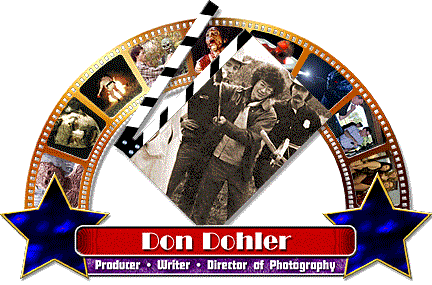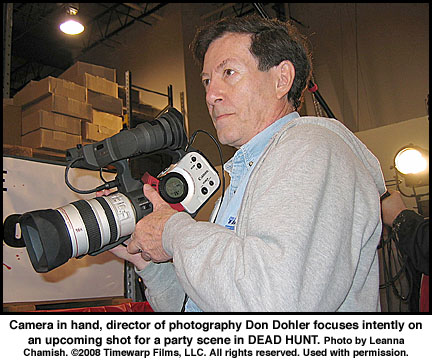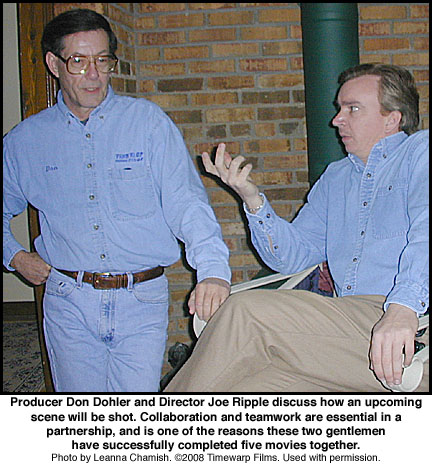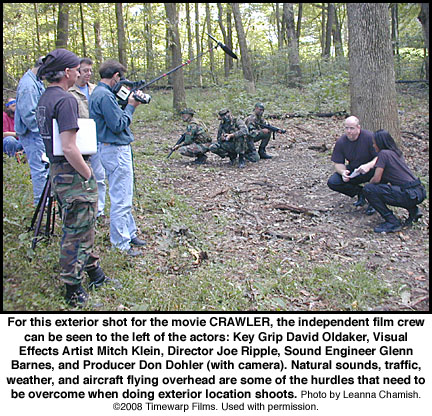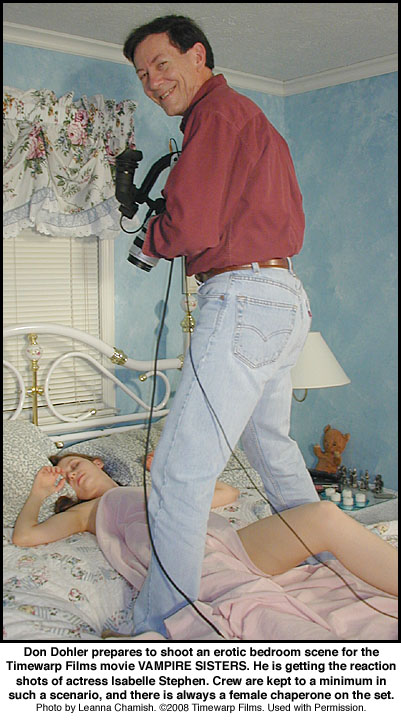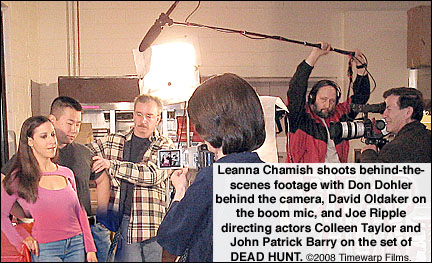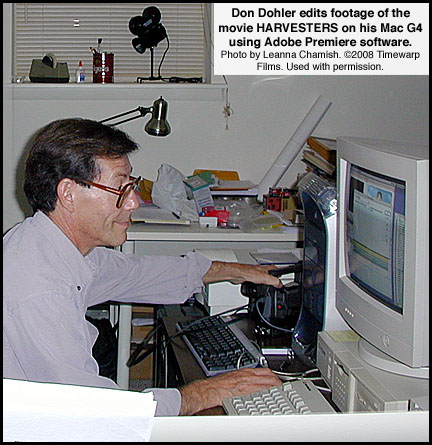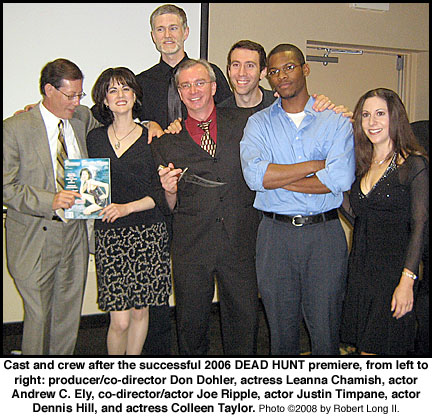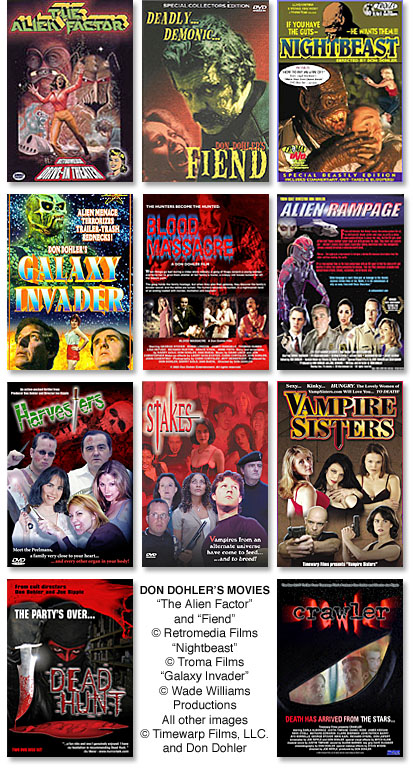Search
An In-Depth Interview With a Legendary
DIY Backyard Movie Producer and Director
Interview ©2005 – 2008 by Robert Long II
Robert: Don, you have worked with both film and video: which do you prefer to work with, and why? What are the pros and cons of both mediums?
Don: I prefer today’s digital video over film — as long as the end product looks like film, or close to it. Naturally, all of my early work was shot on film, because there wasn’t any digital video back in those days. But today’s technology is the main reason I returned to making movies, and it’s what has kept Timewarp Films going. Simply put, we could not afford to be making these movies if we had to shoot on film because of the costs. One 11-minute roll of 16mm film costs well over $120.00; one 63-minute high-end DV tape costs under $7.00! That’s an amazing cost difference. Also, the video equipment is generally smaller and lighter, and therefore easier to use. It allows for much quicker set-ups and mobility than film.
The drawback to video is the inherent way it reacts to light and depth-of-field. Highlights tend to blow out if you’re not careful, especially outdoors in the bright sun. Also, the contrast ratio is more dramatic in digital than film, though with some work on lighting and exposure this can be corrected. Many of the newer cameras — such as the Canon XL2 — shoot in 24-frame mode, which really enhances the “film look,” and offer ways to control details in blacks (dark areas). When the dark areas are “too dark,” you get artifacts — a real annoyance that often shows up on DVDs.
I think one of the reasons our movies look so good — very close to film — is that we light them like film. I see many low-budget, shot-on-video productions where the filmmakers use available light, and it just makes everything look cheesy.
There are also tricks to get a film-like depth-of-field, so that a subject is sharp and the background in racked out of focus. One way is the place the camera farther back than you normally would and zoom in to a medium shot of the subject. This will blur the background more. I’ve also learned that it’s better to “over light” video and stop the lens down, rather than shooting with less light and a large lens opening. This is actually more helpful in wider shots, where you want everything in sharp focus.
Robert: What kind of affordable film or video camera would you recommend to those in the independent film business? What are the pluses and features on these cameras?
Don: The aforementioned Canon XL2 is a good bet, though it’s expensive at a retail of price $5400, and perhaps a wholesale price of $4500. For those starting out, a Canon GL2 is a good bet, because it’s priced very reasonable (they can be found for well under $2000.) and offers frame mode, which is vital to getting the “film look.” It’s not as good as a camera that will shoot in 24-frame mode, but it’s better than a camera that offers neither frame mode or 24-frame mode.
Robert: Don, What kind of lighting equipment do you use? What do you feel is essential as a basic kit for someone starting out in this business?
Don: We have an array of lighting that we’ve pieced together. We have two 2,000-watt Mole Richardson Fresnel studio lights, a Lowell DP kit of 1000-watt lights with scrims and barn doors, and four or five small, incidental Smith-Victor lights with stands. It’s always better to have more lights, but we generally can get by with what we have. Finding appropriate amps to power the lights can be a problem, so we always look for places with multiple circuits (so we don’t overload breakers).
I’d say that anyone getting into digital filmmaking should at least purchase some sort of basic tungsten lighting kit — at a minimum, 2000-3000 watts of total output. Just don’t shoot with incandescent lighting; it looks cheap and lousy.
Robert: Your last several movies have been with your partner Joe Ripple of Timewarp Films. What are pros and cons to this collaborative effort? What compromises have to be met to have a good creative team up?
Don: The obvious pros of our collaboration are that we share responsibilities and we have one another to bounce ideas off of. I never cared for directing, so I asked Joe to take over those duties and he was happy to do so. That allows me to focus on lighting and cinematography — the areas I prefer.
The cons could be that sometimes we don’t agree on story concepts or how a scene should be played. In some cases, this is just a matter of viewpoint. I’d say that we both relent to the other in many instances. For example, there was a line (a pun) in “Vampire Sisters” I didn’t like, so I cut it out. When Joe saw the edited scene, he immediately asked what happened to the line. He pretty much insisted it be restored, so I obliged him. That has also happened the other way around, where I think something Joe has written is not that good, and he agrees to let me cut it.
I’d say the examples I just gave pretty much answer the “compromise” question. Partners have to be willing to compromise. Another solution to some dilemmas is having our Timewarp crew attend meetings (or “bull” sessions) where we all kick around ideas or find solutions to problems. Often, Joe and I will put things to a vote with our team, and the majority wins.
Robert: Don, what kind of preplanning do you do for an upcoming film? Do you storyboard? Do you hold script meetings to get feedback on what will and will not work?
Don: Typically, we hold meetings with our Timewarp crew so that we can all go over the elements of the screenplay before it’s finalized. We recently did this for an upcoming movie called “Dead Hunt.” The script was written (with initial input from Joe and I) by Eric Strauss, and then we sent it to all our crew people, had them read it, make notes, and then we got together to discuss weak spots, changes, etc. Many of the best plot-points of “Stakes” were developed in this “group-meet” fashion. Joe and I often find solutions just by talking with one another on the phone; he’ll come up with something; I’ll have an idea for a character change that makes things better; stuff like that.
We rarely storyboard. I have done this only when I know a particular shoot has limited time at a location and we must get everything done without a chance of going back. I did this for a key group scene in “Alien Rampage” and we did a little storyboarding for key scenes in some of the older movies. But I find that Joe and I are usually familiar with our locations and prefer to plan out shots and angles on-the-spot. The most difficult type of scene to shoot is one involving multiple characters in a shot. These would be the types of scenes that would be good to storyboard.
Robert: Now, are your films self-financed, or do you have investors? If you have investors, what is your advice on how to obtain them?
Don: We had some investors on “Harvesters,” and we had one person invest a small amount in “Stakes.” Everything else – including all of the equipment purchases – was paid for by Joe and I. However, we have a couple of investors in our new movie, “Dead Hunt.” These investors came to us, and the amounts they invested are small. We essentially use investment money to pay for incidentals, such as food for cast and crew, any costs related to using a location, and perhaps a little up-front cash to the actors.
Investors must be people you know on a personal basis; without filing with the Securities & Exchange Commission, you can’t legally advertise for investments; all contacts must be a one-on-one offer. Everybody who has invested in our movies – though the aggregate investment doesn’t even reach $10,000 – have been people we know.
So, it goes back to tapping friends and family to put up money, though I’d say if one can avoid that, it preferable. The less people you owe money to on a movie project, the better!
Robert: Don, of all your projects, what has had the largest budget? Which has had the smallest budget? Can you give me examples of where the money goes on a project? Can you give me cost reasons of why one film is more expensive than the other?
Don: “Nightbeast,” my 1982 film, had the largest budget of any of the movies I’ve done. It had the most visual effects (back when there were no computers and all the FX had to be done on an Oxberry animation stand) and, of course, it was shot on film – which meant big lab bills.
The smallest budget movie is probably “Fiend” for the simple reason it had a very small cast, and I had cut deals for the equipment and lab costs. The only thing I had to spend money for was film stock, which was expensive, but not like it is today.
Timewarp’s lowest-priced movie is “Vampire Sisters” because it mirrors “Fiend” in many respects: largely a one-location shoot, small cast, mostly interiors.
The money goes everywhere but in mine or Joe’s pockets! We are always the last to get paid once the distribution money begins to come in. That’s because our investors (if any) get paid first, then any deferments to actors, and finally Joe and I.
In the digital world, the money goes mostly for supplies: gaffer tape, gels, spare bulbs, canned air, etc. Next would be any props or costumes that have to be purchased, as well as make-up supplies if the project requires them. And, of course, some up-front cash to the cast and crew is always nice. In each of our Timewarp movies, we have purchased and/or constructed new equipment that builds on our inventory. Prior to “Crawler,” we spent nearly $2,000 for parts and supplies so that our key production grip, Dave Oldaker, could build a dolly system for us. Once equipment is bought or built, though, we’ve got it for future use. I would like to add some new lighting in the future, and perhaps a jib-arm rig, but we’re pretty well supplied for now.
One film being more expensive than another is directly related to the size of the cast and crew, the number of locations, how many props need to be acquired or built, whether or not there are make-up FX (and how elaborate they are), and the scope of special visual effects. Expense can often be measured in time, especially if actors are being paid on a “per day” basis – even if it’s deferred. Ultimately, the production will pay for it out of distribution revenues. So, the less days it takes to shoot, the cheaper the movie will be.
Robert: Is there script-writing or script-formatting software out that you recommend using?
Don: Funny enough, I write my scripts in QuarkXpress. I easily formatted a screenplay template that works fine for me. However, Final Draft is what just about everybody in the Hollywood and independent realms uses. It automates much of the work and does many other neat things – such as breaking down each character’s dialogue, just to give one example. It also allows for changes – additions and deletions – with automatic re-formatting. It’s $150-200, but Final Draft is worth the cost.
Robert: Don, who comes up with the story and the script? Is it a collaborative effort? Do you allow outside contributors to submit a story outline or synopsis?
Don: Joe and I are very collaborative when it comes to story ideas and final screenplays. There hasn’t been a Timewarp movie yet that we didn’t both contribute heavily to. We fleshed out the concepts for “Harvesters” early on, then I wrote the screenplay, but incorporated dialogue and plot-points that Joe had written. For “Stakes,” Joe wrote the rough script, then I took it and re-wrote the final version. For “Vampire Sisters,” Joe outlined the basic concept, then I took that and wrote the screenplay and added my own elements to flesh it out. “Crawler” worked in a similar fashion: Joe came up with the initial concept, then I added my concepts; he wrote the first-draft script, then I took that and re-worked it before we shot the movie.
Our latest project, “Dead Hunt,” was actually written by somebody else – not Joe or I. Eric Strauss had the initial concept, then he sent us a short treatment and we provided our input. He wrote a first draft script, and Joe and I looked it over and offered some changes. He wrote a revised script and then we sent copies to our crew and called a meeting with Eric and our crew to hone it down to the best possible concept. This worked well, and during the meeting a suggested change often led to something else changing for the better. This process eliminated some characters, changed the participation of other characters, and altered the demeanor of some characters. But the end result is a better story and better characters.
We are always open to looking at scripts, and we have seen many – often they are good, but just beyond our low-budget means. Eric, who has seen all our movies, went into “Dead Hunt” knowing our limitations and knowing we wanted a one-location movie.
Robert: How do you go about holding auditions for a new project? How do you get the word out? Where do you hold the auditions? Do you have any sort of form for the actors to initially fill out at the audition? Do you video tape the auditions? Do you allow actors to send in video taped auditions with their resumes?
Don: We usually hold auditions at a hotel just off I-95, a major north-south highway that runs through Maryland. A friend of mine is vice president and general manager of a hotel chain, so she always cuts a good deal on the space we use for auditions. The hotel we use is easily accessible for people coming from either the north or south.
We have a Maryland Film Commission, and they have a “hotline” where you can post notices of auditions. People call the hotline and get an audible rundown of current auditions. In the past, we have also posted audition notices on several actor web sites, but that generally brings actors from all over the place. There are also actors locally who network via email with dozens and dozens of other actors, so they sort of help spread the word. And, of course, we post audition notices on our own web site.
We have a standard form actors must fill out before they audition. They list their name, address, phone, cell phone, email – the usual stuff. They check off which character they’re auditioning for, and they check whether or not they’re willing to do non-sexual nudity if a role requires it. We attach this form to their headshot so that we have easy reference later on. Naturally, we have each actor “slate” into the camera (name and phone number) before they read.
We always tape auditions. I’d say it would be nearly impossible to cast without taped references. Often you’ll see something on tape later that wasn’t apparent during the “live” audition – a little nuance that makes an actor stand out. We have allowed actors to send in taped samples, but we don’t prefer this method. We’d rather have them there at our auditions doing lines opposite another actor. In most cases, after we’ve gone through our audition tapes and weeded out the actors who we know we don’t want, we’ll hold call-backs. We usually send call-back actors new sides and tell them to learn the lines so they can come to the call-back totally prepared. That way, we’re seeing them perform as they would if we were actually shooting.
Robert: Don, besides the cast, what does your crew usually consist of? As you probably do not have a grip truck, how is equipment gotten from location to location?
Don: Our crew is very small. Dave Oldaker is our key production grip, and through “Crawler,” my brother Glenn handled sound recording (he has since dropped out because of a new work schedule that prevents him from actively participating). Joe, me, Mitch Klein, Sean Quinn and Leanna Chamish are the rest of our “crew” and we all pitch in to get things done. Dave handles most of the “setting up” – running electrical, setting up and rigging the dolly tracks, etc. We all help out, though, and lug lights and help run cable, especially if it’s a wide-open location (we had many of these during “Crawler”) and electric cable has to be run hundreds of yards through woods.
We haul our equipment in Dave’s van, and he has a large open trailer he uses for all the heavy gear, such as the dolly cart, the large lights and stands, the master electric box, and stuff like that.
Robert: How is costuming handled on a project? Is it “everybody wear what you want to wear” or are the costumes actually cleaned and put back on the rack at the end of the day? Does the cast supply their own costuming, is it supplied to them, or do you have a wardrobe allowance for them?
Don: This all depends on the movie. For “Stakes,” Joe took Leanna Chamish shopping for a special wardrobe, since she played the Queen Vampire and he had specific ideas how he wanted her to look in various scenes.
In most cases, we give actors a rough idea of the types of clothing we want and they bring several items with them for us to choose from. I generally let Joe handle the wardrobe selection, though there are times when we’ll have so many good choices, we put it to a vote.
In some cases, such as when I made “Alien Rampage,” I sent the three actors playing the sheriff and deputies to a uniform company that specializes in cop wardrobe. They were measured and the uniforms were custom-tailored to each actor. Most of the time, though, actors supply their own wardrobe and it’s an expense we can avoid.
Robert: You have worked both within sets and natural locations. What are the pros and cons of both?
Don: This is pretty easy: when you’re on location, particularly outside, you’re susceptible to all of the elements that can screw up a take – planes, traffic, birds, bugs, lawnmowers, wind, cold and heat, clouds obscuring the sun (messes up continuity) and so on. Inside, for the most part, you have much more control and none of the elements that can foul a take. I prefer interior shooting for the sheer ease and control, but there is a side of me that likes the challenge of shooting outside. If you want a quick and relatively painless shoot, though, it’s better to set a movie mostly indoors.
Robert: You’re on the set, miles from civilization, and “nature calls”. When on remote locations, how have you handled bathroom facilities for cast and crew?
Don: We try to find exterior locations that have accommodations, but some of them have not. In that case, it’s sneak off behind the closest tree! This isn’t any big deal for men, but I know it can be uncomfortable for women. That’s another advantage to interiors – just about anywhere you shoot (a house or building) is going to have restrooms, so it makes the shoot that much more enjoyable.
Robert: What kind of food prep, or catering do you set up for the cast and crew on film days? What kind of food is available and prepared?
Don: This is usually us sending a crew person out for food if we’re in a remote location. If we’re doing interiors, we can send out for pizza or sandwiches, or provide snacks and drinks. Sometimes we’ll just take the cast and crew to a restaurant between shoots (such as when we wrap a day shoot and are waiting to do a night shoot with the same people). Our casts and crew are pretty good about this; many people bring their own snacks and some of them bring their own food – because of specific diets or preferences they might have.
Robert: Don, while you may have employed special effects artists and make-up artists in your films, have you ever used a make-up artist for the glamour of the actors and actresses, or is that up to the individual performer?
Don: I did this on the first, aborted “Nightbeast” back in 1979. A friend of mine owned a beauty salon and he and a make-up artist came to location every day and did the hair and cosmetic make-up on the actors. But frankly, this is a Hollywood-type perk, and something I’ve never again bothered with. Sean Quinn provided face powder for all the actors in “Harvesters,” just to keep the “sheen” from their faces. That – and what make-up the actors do themselves – usually suffices.
Robert: While perhaps most of your actors and crew might be from your local area, how do you handle actors and actresses that have to come from out of state. Where are they put up after the day wraps?
Don: A few times, Joe has put up a couple of actors at his house, but only when the actors had a two-to-three-hour drive and we were going to be shooting very late. A couple of other times we provided hotel rooms if a shoot warranted it. Generally, though, the actors simply commute. We always ask up front if somebody has traveled quite a distance to audition if they’re really willing to make the commute to shoot the movie. They usually say “yes.”
Robert: Don, here’s an interesting question; due to the many different personalities that you can encounter from cast and crew, how do you handle any friction or situations that spring up from time to time?
Don: Well, on “Harvesters” we had some friction that began with one actor and “spread” to a couple of others. It was pretty unwarranted complaining, but we called a meeting and let them air their concerns. It kind of ticked me off because the complaints were so trivial compared to some of the harsh conditions I recall our actors going through on “The Alien Factor” and “Nightbeast” (with never one complaint). But, since we were in the middle of shooting, we had no choice but to try and coddle these few crybabies and get through the movie – vowing that we would never call on these particular actors again. And we never have.
Robert: In your last several features, you have dealt with nudity on the set. What is the proper conduct and the way to deal with this matter so everyone involved is comfortable, and you get the shots you need?
Don: The nudity scenes are simple: only essential personnel are on set, and we always have a chaperone, especially with females doing nudity. Generally me and the chaperone are the only ones watching, but that’s because I’m doing the cinematography. The other essential people are obviously Joe and the sound person, but they usually position themselves where they can do the job without staring at the actor. Some actors we’ve used have absolutely no inhibitions – one in particular I recall stripped down and pranced around stone naked freely in front of everyone. Another looked as though she was going to choke trying to take off her top for the camera. Generally, people willing to do nudity have no qualms about it or they wouldn’t check “yes” on our sign-up form!
Robert: How do you go about scheduling actors and crew members for the days they are needed? Do you have someone in charge of continuity, logging and such? Do you shoot just weekends for a feature, or have you had a scenario where everyone takes a week off to shoot the full week non-stop?
Don: When we go into a production, we make sure all the actors are available for a particular stretch – our planned schedule for getting all the shooting done. If they have conflicts, we ask actors to tell us about them up front. But if we run into postponements because of weather and are pushed behind schedule, we then have to work around the actors and when they can be available. This happened on “Crawler.” It rained often right after we started, and we ended up going more than a month beyond our intended completion date. As a result, we had to schedule actors when they could squeeze in the time.
We honestly have not had anyone handling continuity on Timewarp movies, only because there isn’t anyone extra we can spare for the job. My daughter, Kim, did that for “Alien Rampage,” and it was very helpful. So, Joe and I (with some help from the cast and crew) have to keep track of continuity. Sometimes we screw up, but most people watching the finished movie don’t ever notice.
Weekends are our main shooting days. That’s because just about everybody – cast and crew – works regular day jobs. Occasionally we’ll schedule a shoot at night during the week, but only if we need to “catch up” on our schedule. We have never had a situation where everybody takes off and shoots for a solid week.
Robert: Don, what importance do you put on having a crew member documenting the behind-the-scenes making of the movie, as well as taking photos of the characters at the locations and sets you are using?
Don: Leanna Chamish has been our video documentarian since we began Timewarp. After she was cast as Betty Peelman in “Harvesters,” she asked if we’d mind if she did the behind-the-scenes footage. We were thrilled that she wanted to do it! Naturally, her footage provided the “Making of” segment on the DVD and she continued being our behind-the-scenes videographer ever since. In terms of importance, I’d say it’s vital to have someone documenting the production in this age of DVD.
Leanna also shoots many of the production stills, although Joe and I have done some of that, too. On “Stakes,” a professional photographer friend of mine named Joe Kohl shot our stills. But Joe at the time didn’t know he had been stricken with leukemia. He went into the hospital mid-way through our shoot and subsequently went into a coma and never recovered. After that, Glen Weisgerber, also a professional photographer, joined us for some “Stakes” publicity photos. Glen shot the stills for “Vampire Sisters,” then moved to Puerto Rico. So, we’re once again without a professional photographer, and it hurts. “Crawler” lacks good stills and it’s made doing promotional posters and art very difficult.
Stills of the characters and locations are not that important for continuity or reference when you’re shooting digital video. I can easily look at footage to see what people were wearing or how they were positioned if we need to finish a scene later on.
Robert: Some filmmakers do everything they can to cover brand names of products in a movie, some blatantly don’t care if they show. What are the rules to product placement? Have you ever used any product placement in your features?
Don: Product placement is a whole separate specialty that is mostly reserved for the big Hollywood movies. There are people at the studios who specialize in contacting companies who pay to have their product clearly displayed in movies. In our case, I never pay attention to it. If a Coke machine is in the background, that’s just the way it is. I don’t go out of my way to highlight it or avoid it.
There are no “rules” to product placement, other than companies paying big bucks to have the product visible in movies. If a product is in a shot in an incidental way, it’s fair game – that does not violate any copyright law. But I would happily place a product if some company wants to throw some money at us – except for cigarettes. I don’t know if anybody has ever noticed, but we never have any of our actors smoking in our movies. Many of them do smoke, but I’m against promoting it.
Robert: Don, since everything is practically done on computers these days, can you tell me what software you edit your features with? Are you on a Macintosh or a PC? What do you feel is the bare minimum of hardware and software that you need to edit a feature?
Don: I’m on an older MacIntosh G4, but it does fine. I know there are newer, faster machines, but for now, my five-year-old G4 gets the job done. I have edited all of the recent movies on Adobe Premiere. I know that Apple’s Final Cut is a more robust program, and I’ll eventually go that way, but Premiere has done the job for me with few problems.
Two things are essential for video editing: as much RAM as you can get on the computer and as many extra internal and external hard drives as you can afford. I’ve got 130 internal gigs on my G4 and three external drives with a total capacity of 240 gigs. You can ever have too much storage space with these huge video files!
Robert: With 10 films and counting, you have had to deal with several sound effects and soundtracks for these movies. How do you handle these subjects? Have you hired composers? Do you use stock music and sound effects libraries? What would you recommend to someone starting out?
Don: In many cases I have created sound effects, but more in the old days than in the newer movies. There are so many sound FX libraries available now that you can find just about anything you need. I have purchased the 10-disk 20th Century Fox sound effects library, and several smaller libraries. For now, these suffice. For “Crawler,” Joe searched the web and purchased some “monster” roaring sound effects especially for the title creature.
Our music has been done in a variety of ways. Sean Quinn, Joe and I got together for many sessions to create the “Harvesters” score. For “Stakes” I used stock music that is nothing more than dozens of small musical pieces that you cut together to “create” a score. Mitch Klein scored much of “Vampire Sisters,” but I purchased some original stock music to fill in the blanks. For “Crawler,” one of our lead actors, Justin Timpane, is doing an entire original musical score. That’s the preferred way, because his score is thematically tied together and each piece is composed specifically to a sequence.
For newcomers, if they don’t have a friend who can do a score, I’d say to search the web for stock music. It’s widely available and can be purchased at a reasonable cost.
Robert: Don, your film is in the can, it’s edited, and sound and special effects have been added. How do you go about finding a distributor? Do you have a favorite distributor that people should try first?
Don: This is a crap-shoot. When we finished “Harvesters,” we sent email pitches to about 60 distributors who dealt with “horror.” About 25 of them requested a screener. After we sent out the screeners, only a couple of them expressed interest. Finally, Mike Clarke of Key East Entertainment came to Maryland, met with us, and made us an offer to distribute the movie. Later, we automatically went with Mike for “Stakes,” but we shopped “Vampire Sisters” around and settled on Brain Damage Films. We subsequently also signed up “Alien Rampage,” “Harvesters” and “Stakes” with Brain Damage for overseas sales, as well. And, of course, we’ll likely shop “Crawler” around, though Brain Damage will get one of the first screeners.
There are very few distributors handling indie product these days, and many of them are low-rent operations. Still, a filmmaker should shop a movie around as widely as possible to see who offers the best deal. I know there are some really bottom-of-the-barrel distributors out there (I won’t mention names) who will put out almost anything, but chances are the movie will get sparse distribution and make little, if any, money.
Robert: What kind of marketing materials should you have on hand to promote your feature?
Don: You need a dynamite trailer to go with a screener. A screener is the finished feature with protective “For Screening Purposes Only” burned over a portion of the image. And you need sell-sheet art that looks as slick and dazzling as you can make it. If the movie gets any advance reviews, pull out some good quotes and include them on the art.
Robert: Do you hold premieres of your movies or throw a wrap party at the end of filming?
Don: We always have cast/crew premieres of our movies. We usually rent a banquet hall at a hotel that is equipped for video projection, although we are considering holding the “Crawler” premiere at an actual movie theater.
Wrap parties depend on when we finish a movie and the time of year. We never did a wrap party for “Harvesters,” but we had one for “Stakes.” We skipped one for “Vampire Sisters,” but held a wrap party for “Crawler” in January – two months after finishing principal photography. That’s because we finished just before the holidays and figured it was better to wait for the party until after the holiday season was over.
Robert: Don, are there any genres that you wish you were doing, but can’t because of money constraints (or the market isn’t there) and is there any genres that you refuse to touch, and for what reasons?
Don: One of the genres I love – but isn’t even that popular anymore – is musicals. Obviously, though, it would be way beyond our means to do an original musical! I like action movies, but again – we don’t have the money for the elements you need for action flicks. So, we do the best we can in the horror and sci-fi genre.
We absolutely will not do porno. We were approached by some people three years ago who said they’d put up money for us to do porn, but we turned them down flat.
Robert: In this age of DVD competition, do you feel it is important to pack extras such as commentary, behind the scenes, and bloopers?
Don: It’s pretty obvious that DVD extras are vital – and we’ve been right on target with them since we began Timewarp Films. How many low-budget movies like ours do you see with extras that rival (and often surpass) big Hollywood DVD releases? It’s now a “given” to have commentaries, behind-the-scenes featurettes, deleted scenes, bloopers, still galleries and whatever on DVDs. That’s part of what has contributed to the huge sell-through success of DVDs – that and the superior picture and sound quality over VHS.
Robert: Don, thank you so much for this great, in-depth interview. It is my hopes that your words of wisdom will help many a filmmaker.
Don: My pleasure.
Don Dohler was a veteran of independent filmmaking, and had been making movies since he was 12 years old. He won several awards for his short films in the 1960s and early 1970s, and wrote and directed his first feature, The Alien Factor, in 1977. The movie landed a worldwide TV syndication deal and evolved into an international “cult” favorite, establishing a large fan base for Dohler around the globe. Dohler followed this success with Fiend (1980), Nightbeast (1982), Galaxy Invader (1985), and Blood Massacre (1988). In 1972, Dohler founded Cinemagic Magazine, whose contributors were talented filmmakers and FX artists, many of whom later became Oscar© winners in Hollywood (among them Rick Baker). After a 10-year hiatus, Dohler returned to moviemaking in 1999 with Alien Rampage, which he wrote, directed, edited and co-produced. Joe Ripple was cast in a featured role, and he and Dohler became friends. At Dohler’s suggestion, the two men began Timewarp Films in 2000 and Ripple came on board as the director. Dohler produced, photographed and edited all of Timewarp’s movies; he and Ripple usually collaborated on the screenplays. He passed away of cancer in December of 2006. A documentary by filmmaker John Kinhart of Dohler’s life and career has been shown at movie festivals all over the world, winning awards and rave reviews.
Don Dohler links:
